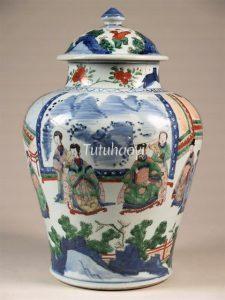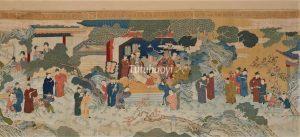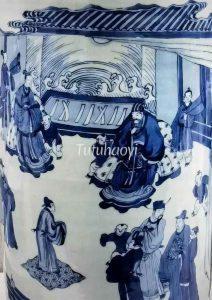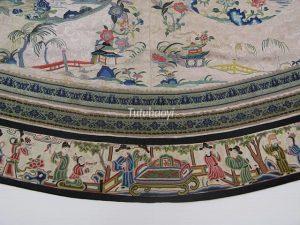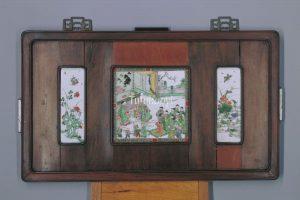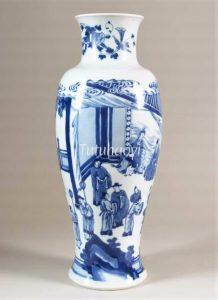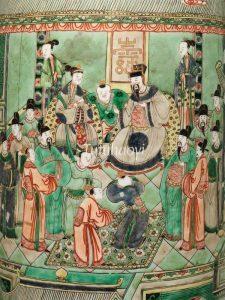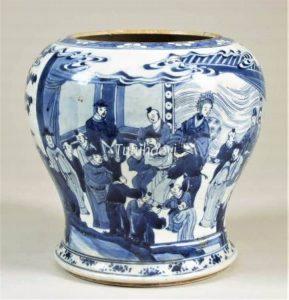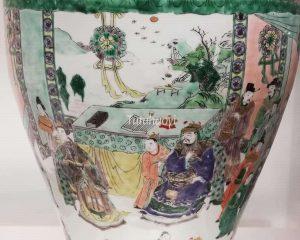A Bed Piled with Hu Sceptres (Guo Ziyi’s Grand Birthday Party)
满床笏 (郭子仪拜寿)
© Tutuhaoyi.com owns the copyright of the description content for the images attached. Quoting all or part of the description content on this page is permitted ONLY IF ‘Tutuhaoyi.com’ is clearly acknowledged anywhere your quote is produced unless stated otherwise. (本页描述内容版权归Tutuhaoyi.com所有,转发或引用需注明 “Tutuhaoyi.com”, 侵权必究, 已注开源信息的条目除外。)
Guo Ziyi (郭子仪 697–781), a native of Huazhou 华州 (a county near present-day Xi’an 西安), was the most prominent general-statesman of the Tang dynasty. For the great part of nearly thirty years and under a succession of four different emperors, he played a key role in maintaining the stability of the country. He helped to keep the nomads in the northern frontier at bay and managed to subdue the rebellion led by two powerful warlords An Lushan (安禄山 703–757) and Shi Siming (史思明 703–761).
Guo Ziyi is considered to have had an ideal personal life because he had eight sons and seven daughters and all of the male adults in his extended family served as high-ranking officials at the imperial court. In imperial China, officials went to court to have an audience with the emperor carrying an elongated tablet hu (笏) for taking notes. With the increasing popularity of paper, the hu tablet evolved into a status symbol for court officials. Whenever Guo Ziyi had a birthday party in his mansions, he had to set aside a large bed to accommodate the large number of hu tablets or sceptres brought by his distinguished guests and family members. So the coined phrase ‘a bed piled with hu sceptres (满床笏 man chuang hu)’ describes a scene associated with a powerful personality.
Guo Ziyi safely left his political and military career at the age of seventy-two and passed away at eighty-five, regarded posthumously in the Chinese society as an epitome of the Three Abundant Blessings (三多 san duo). He enjoyed all of them: great good fortune, longevity, and abundant offspring, the apogee of a person’s life-long achievements.
In artistic depictions of the scene, the bed piled with ivory or bamboo sceptres is usually highlighted but often misunderstood. Sometimes, the artist may omit the bed with piled hu sceptres on it but the scene remains a welcome gift for a respected person’s birthday.
image identification and literature research by Dr Yibin Ni
More stories about Guo Ziyi:
How did Guo Ziyi deter the colossal enemy army without fighting?
Fig 1: porcelain plaque with overglaze enamelled decoration, Kangxi period (1662–1722), Qing dynasty, courtesy of Burrell Collection, Scotland, the UK
Fig 2 and 3: porcelain lidded jars with underglaze blue and overglaze enamelled decoration, Kangxi period (1662–1722), Qing dynasty, courtesy of Princessehof Ceramics Museum, Leeuwarden, The Netherlands
Fig 4: Kesi fabric (detail), 19th century, courtesy of the Metropolitan Museum of Art, New York
Fig 5-6: porcelain vase with underglaze blue decoration, Kangxi period (1662–1722), Qing dynasty, courtesy of the Palace Museum, Beijing
Fig 7: embroidered fabric (detail), Qing dynasty (1644–1911), location to be confirmed
Fig 8: ivory hu sceptre, Ming dynasty (1368–1644), Jiangxi Museum, China, courtesy of Wikipedia
Fig 9: porcelain tile with overglaze enamelled decoration, Kangxi period (1662–1722), Qing dynasty, courtesy of the Palace Museum, Beijing
Fig 10: porcelain vase with underglaze blue decoration, Kangxi period (1662–1722), Qing dynasty, courtesy of the Museum of Fine Arts, Boston, Accession number 51.2629
Fig 11: porcelain vase with underglaze blue decoration, Kangxi period (1662–1722), Qing dynasty, courtesy of Princessehof Ceramics Museum, Leeuwarden, The Netherlands
Fig 12-13: porcelain vase with overglaze enamelled decoration, Kangxi period (1662–1722), Qing dynasty, courtesy of the Metropolitan Museum of Art, New York
Fig 14: porcelain pot with underglaze blue decoration, Kangxi period (1662–1722), Qing dynasty, courtesy of Princessehof Ceramics Museum, Leeuwarden, The Netherlands
Fig 15-16: porcelain vase with overglaze enamelled decoration, Kangxi period (1662–1722), Qing dynasty, courtesy of University Museum and Art Gallery, The University of Hong Kong; Photograph by Simon Ng

